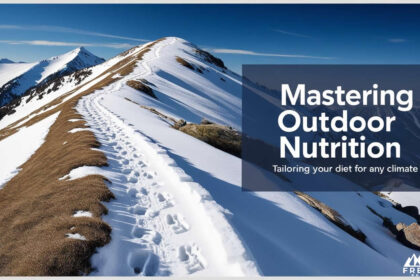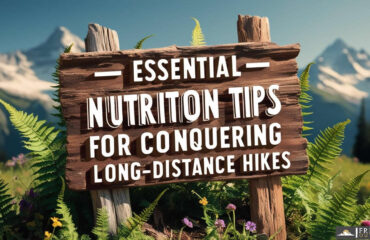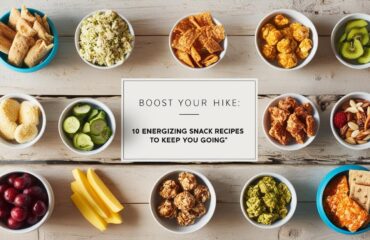
Discover how to adapt your outdoor nutrition strategies for optimal performance in varying climates and ensure your well-being during outdoor activities.
Understanding the Importance of Outdoor Nutrition in Varying Climates
Outdoor nutrition is crucial for optimal physical performance and overall well-being, particularly when engaging in activities across a range of climates. The nutritional requirements of individuals participating in outdoor sports can vary significantly depending on the environmental conditions they encounter. For example, a long-distance runner in the humid heat of summer will face different hydration and energy demands than a mountaineer traversing snow-covered peaks in winter. This highlights the importance of adapting nutritional strategies to enhance energy levels and hydration tailored to specific climates.
Recognizing how different climates impact nutrition can help individuals better prepare for their outdoor pursuits. Without proper nutrition, athletes may experience decreased performance, fatigue, or even injuries due to insufficient energy or hydration. A hiker in a hot climate, for instance, might not only struggle with hydration but may also experience heat exhaustion if they fail to consume adequate electrolytes and fluids. This scenario underscores the necessity of understanding and adapting nutrition to the environment in which one is active.
Importance of Climate-Specific Nutrition
Nutritional needs are influenced by various factors, including temperature, humidity, and altitude. These factors can drastically affect hydration status and energy requirements. For example, in hot and humid conditions, the body loses fluids rapidly through sweat, necessitating a higher intake of water and electrolytes to maintain balance. Conversely, individuals participating in outdoor activities in colder climates may require a significant increase in caloric intake to compensate for the energy expended in maintaining body temperature during exposure to cold. Such variations in climate-specific nutrition are crucial for optimizing performance and health while participating in outdoor sports.
Additionally, seasonal changes can significantly affect food availability, requiring individuals to adjust their dietary choices accordingly. For instance, winter may limit access to fresh produce, leading to potential nutrient deficiencies if one does not adapt their diet. Understanding which foods are in season and how they can contribute to nutritional needs is vital for maintaining energy levels. For example, root vegetables may be more accessible in winter, providing necessary carbohydrates and nutrients to support outdoor activities during colder months. Recognizing local agricultural practices can also enhance food sourcing and choices, allowing individuals to support local economies while optimizing their nutrition.
Nutritional Needs in Cold Climates
During winter outdoor activities, increasing caloric intake by 10-15% is necessary to sustain energy levels and counteract the body’s heightened energy demands due to cold exposure. The recommended macronutrient ratio in cold climates typically includes 60-65% carbohydrates, 20-25% fats, and 15-20% protein. This balance is essential, as carbohydrates provide quick energy, fats contribute to longer-lasting energy stores, and protein aids in muscle recovery and repair after strenuous activities.
Cold exposure can lead to dehydration, often an unexpected hazard, as many individuals may not feel thirsty in frigid temperatures. This phenomenon, known as cold-induced diuresis, necessitates regular hydration, even when thirst signals are suppressed. For example, a snowshoeing enthusiast might overlook hydration needs while enjoying the winter landscape, only to find themselves fatigued or disoriented later. Including foods rich in healthy fats, such as avocados and nut butters, can provide the energy density required for sustained activity in cold environments. Moreover, warm beverages like herbal teas or hot chocolate not only assist in hydration but also help maintain body temperature, making them a comforting choice during chilly conditions.
A practical approach for outdoor enthusiasts in cold climates includes planning meals that provide warmth and sustenance. Consideration should be given to packing energy-dense snacks that are easy to consume on the go. For example, trail mix containing nuts, dried fruits, and seeds can provide a quick source of energy while being lightweight and portable. Additionally, warm meals, such as hearty soups or stews, can be made in advance and kept in insulated containers, ensuring they remain at a safe temperature for consumption during activities.
Nutritional Needs in Hot Climates
In hot climates, hydration becomes paramount due to increased sweating and fluid loss. As humidity rises, so does the need for electrolyte replenishment to maintain optimal hydration levels. Foods like coconut water and leafy greens are particularly beneficial in hot conditions, providing essential minerals and fluids that are lost during vigorous outdoor activities. For instance, a cyclist riding through a scorching summer day may find that consuming electrolyte-rich beverages significantly enhances their endurance and overall performance.
Moreover, in warmer climates, lighter meals are preferable to avoid the discomfort associated with heavy food intake. Smaller, more frequent meals can help maintain energy levels without overwhelming the digestive system. For example, rather than consuming a large, heavy lunch, a hiker might opt for a series of energy bars and fresh fruits that are easy to digest and provide sustained energy. Incorporating cooling foods like yogurt, smoothies, or salads can assist in regulating body temperature while delivering necessary nutrients, making them excellent choices for outdoor adventures in hot weather.
It’s important for outdoor enthusiasts to develop a hydration strategy tailored to the demands of warm climates. Regularly scheduled hydration breaks can encourage consistent fluid intake, helping to mitigate the risks associated with dehydration. Carrying a hydration pack can facilitate easy access to fluids, ensuring that individuals can sip water or electrolyte drinks frequently while on the move.
Hydration Strategies for Extreme Temperatures
The hydration needs of outdoor enthusiasts can vary greatly between hot and cold climates. In hot environments, individuals must consume significantly more water to counteract the increased fluid loss from sweating, while in cold environments, thirst signals may be suppressed, leading to inadequate hydration if not actively managed. Regular hydration breaks are essential, even if one does not feel thirsty, as dehydrated individuals may struggle to perform at their best. A winter skier might overlook hydration needs, mistakenly assuming they are not sweating, which can lead to fatigue and decreased performance.
Electrolytes play a vital role in maintaining hydration, especially during intense outdoor activities. Consuming electrolyte-rich drinks or foods can replenish lost minerals and support energy levels during prolonged exertion. For example, a trail runner might choose electrolyte tablets or drinks during a long run to ensure they remain adequately hydrated, particularly in hot weather. Carrying hydration packs or bottles designed for easy access can facilitate regular fluid intake during extended outdoor activities, preventing dehydration before it sets in.
Monitoring urine color serves as a practical indicator of hydration status, guiding individuals to adjust their fluid intake as necessary. A darker urine color may signal dehydration, prompting the need for increased fluid consumption. Outdoor enthusiasts should be mindful of their hydration needs and consider establishing a hydration schedule to ensure they are adequately prepared for the demands of their activities, regardless of the climate.
Recommended Foods for Cold Weather Activities
Energy-dense foods are essential for maintaining performance and warmth during cold weather activities. Nuts, seeds, and energy bars are ideal choices due to their high caloric content and convenience for snacking on the go. Consuming warm meals, such as hearty soups and stews, not only provides the necessary calories but also helps maintain body temperature during outdoor excursions. For example, a winter backpacker might prepare a thermos filled with a hot, nutrient-rich soup to enjoy during a break, allowing them to warm up and refuel simultaneously.
Carbohydrate-rich foods are particularly crucial for sustaining energy during prolonged outdoor activities in the cold. Whole grains, fruits, and root vegetables can provide necessary fuel for activities like skiing or snowboarding. Including protein-rich snacks such as jerky or cheese can further support muscle recovery and prevent fatigue during cold weather adventures. For instance, a climber might carry protein bars that are easy to consume while scaling a snowy peak, ensuring they have the energy needed for their ascent.
To ensure meals remain warm and safe to eat, utilizing insulated containers is a practical approach. This can be especially beneficial when engaging in full-day winter activities, as it allows individuals to enjoy hot meals that provide both nutrition and comfort. Meal planning should consider the types of foods that can withstand cold temperatures without spoiling, allowing for a variety of options that cater to different tastes and preferences.
Recommended Foods for Hot Weather Activities
In hot weather conditions, focusing on fresh fruits and vegetables with high water content is essential for maintaining hydration. Foods like watermelon and cucumbers not only provide necessary hydration but also deliver vital nutrients. For example, a hiker might pack slices of watermelon in their backpack for a refreshing snack that hydrates while providing a quick energy boost. Additionally, snack options should emphasize light, easy-to-digest foods, such as trail mix or granola bars, which can provide necessary energy without causing discomfort during activities.
Incorporating frozen fruits into meals or snacks can offer a refreshing boost of hydration and energy during hot conditions. For instance, blending frozen berries into a smoothie can create a nutritious and cooling drink that is both hydrating and energizing. Foods rich in antioxidants, such as berries, can help combat oxidative stress caused by heat exposure, providing additional health benefits.
Drinking smoothies made with hydrating ingredients can serve as both nourishment and a cooling treat. For example, a pre-activity smoothie made with yogurt, spinach, and banana can provide essential nutrients while also helping to lower body temperature. Developing a repertoire of easy-to-prepare, hydrating snacks can significantly enhance outdoor experiences in warm climates.
Nutrition Timing for Outdoor Activities
Proper timing of meals and snacks is critical for sustaining energy levels during outdoor activities. It is generally recommended to eat 1-2 hours before engaging in strenuous outdoor activities to ensure optimal energy availability. For instance, a cyclist might consume a carbohydrate-rich breakfast before an early morning ride, ensuring they have the fuel necessary for their journey. During the activity, consuming snacks every 45-60 minutes can help maintain energy levels and prevent fatigue, especially during prolonged exertion.
Refueling within 30 minutes post-activity is vital for recovery, as the body needs to replenish lost nutrients effectively. This can include a combination of carbohydrates and protein to support muscle repair and restore glycogen levels. A climber finishing a day on the mountain might choose to eat a protein-packed meal shortly after descent, enabling their body to recover more quickly and prepare for the next day’s challenges.
Pre-activity meals should focus on carbohydrates for quick energy release, while post-activity nutrition should include a balance of protein and carbohydrates to support recovery and muscle repair. Understanding individual energy needs and adjusting meal timing accordingly can greatly enhance overall performance and endurance in outdoor activities.
Seasonal Nutrition Adjustments
As seasons change, the availability of food and nutritional requirements also shift. Understanding local food availability during different seasons can significantly enhance nutritional intake and help individuals adapt their diets accordingly. For instance, winter may limit access to fresh produce, requiring outdoor enthusiasts to rely on stored or preserved foods that are nutrient-dense. Adapting dietary choices to incorporate seasonal foods not only aligns with nutritional needs but can also improve food security and sustainability.
Planning meals and snacks around seasonal changes allows for better utilization of fresh produce and can enhance overall health. Seasonal cooking methods can also enhance nutrient retention and flavor, making meals more enjoyable. For example, roasting seasonal vegetables in the fall can bring out their natural sweetness while providing essential vitamins and mineral. Exploring local markets can provide opportunities to discover fresh, climate-appropriate food options that cater to the changing seasons and local agricultural practices.
Additionally, individuals relocating to different climates may need to adjust their nutritional strategies based on local food availability and cultural practices. Engaging with local food sources can foster a deeper connection to the environment and enhance dietary choices, allowing for a more sustainable approach to outdoor nutrition. By staying attuned to seasonal changes and local offerings, outdoor enthusiasts can ensure their nutrition aligns with their activity demands throughout the year.
Practical Tips for Packing Outdoor Nutrition
Packing outdoor nutrition requires careful consideration to ensure that food remains fresh and safe to consume throughout excursions. Utilizing insulated bags to store snacks can help maintain temperature and prevent spoilage, which is particularly important in extreme conditions. For instance, packing a thermos with a warm drink or soup can provide both nutrition and comfort during a cold-weather hike. In cold conditions, storing water bottles upside down can help prevent freezing, ensuring access to hydration when it is needed most.
Using insulated containers for warm drinks during winter activities is another practical tip that can enhance enjoyment and hydration. This approach allows individuals to sip on hot beverages that provide warmth and hydration while enjoying outdoor adventures. Resealable bags can effectively portion snacks for easy access, making them convenient to grab while on the go. Organizing food items based on meal timing can streamline your eating schedule during outdoor activities, ensuring that you fuel your body appropriately throughout your adventure.
Creating a well-thought-out packing strategy for outdoor nutrition can enhance performance and enjoyment. For example, grouping snacks by type—such as energy-dense foods and hydration options—can simplify decision-making during active outings. This organization can help ensure that individuals can quickly access the nutrition they need when energy demands are high, optimizing their overall outdoor experience.
Tailoring Outdoor Nutrition for Optimal Performance
Tailoring outdoor nutrition to specific climates is essential for maintaining performance, hydration, and overall health. Small adjustments in dietary choices can lead to significant improvements in outdoor experiences, allowing individuals to thrive in various environments. For instance, an athlete preparing for a mountain race may choose to focus on carbohydrate-rich foods in the days leading up to the event, ensuring they have adequate fuel for the demands of high-altitude running.
Embracing climate-aware nutrition supports both personal health and environmental sustainability. This approach encourages individuals to consider the broader impacts of their dietary choices on local ecosystems and agricultural practices. Regularly assessing and adjusting dietary practices in response to changing climates can enhance long-term outdoor performance and satisfaction. For example, outdoor enthusiasts who adapt their nutrition based on local seasonal offerings are more likely to maintain optimal health and performance.
Engaging with nutrition experts can provide personalized guidance based on individual needs and specific climate conditions. For example, a sports nutritionist may work with an athlete to develop a tailored meal plan that considers the unique challenges of competing in different environments, such as high humidity or cold temperatures. This personalized approach can lead to improved performance and a more enjoyable outdoor experience.




